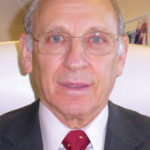
Amyloidosis, the relatively rare condition that presents in many different ways and is often difficult to diagnose, is caused by the extracellular accumulation of the body’s own proteins in an abnormal, insoluble fibrillar form. The amyloid fibril deposits disrupt the structure and the function of tissues and organs, leading to serious morbidity and mortality.
Professor Sir Mark Pepys, MD, PhD, FRCP, FRCPath, FRS, FMedSci, on Monday will explore the current treatments and prognosis for the different types of amyloidosis. The symposium, Update on Amyloidosis 2017, will be held from 1:00 – 2:00 pm, in Room 6 D. Dr. Pepys, Director of the Wolfson Drug Discovery Unit at the Centre for Amyloidosis and Acute Phase Proteins, Royal Free Campus, University College London, is a pioneer in the study of amyloidosis and was knighted in 2012 for “services to biomedicine.”
“Systemic amyloidosis is the cause of death of about one in 1,000 people in developed countries, so while it is a relatively rare condition, it has considerable medical importance for a number of reasons,” Dr. Pepys said. “Most importantly, it is almost always fatal. Also, it is challenging to diagnose and is, in fact, often missed.”
The most common type of amyloidosis seen in developed countries is systemic AL amyloidosis, which Dr. Pepys said is caused by monoclonal immunoglobulin light chains produced by B cell/plasma cell dyscrasias in the various forms of monoclonal gammopathy.
“The aim of all treatment in systemic amyloidosis is to reduce and, if possible, abolish the supply of the precursor proteins that form the amyloid fibrils,” Dr. Pepys said. “Meanwhile, the function of organs damaged by amyloid must be supported and, if necessary, replaced so that the patient can survive long enough to benefit from the arresting accumulation of amyloid.”
If that can be achieved, organ function can stabilize and, in some patients, amyloid regresses and organ function improves.
AL amyloidosis treatment predominantly involves cytotoxic chemotherapy, Dr. Pepys said, but nearly all patients experience major side effects. Some die from the toxicity of the drug.
“So when we treat these patients, we walk a tightrope between trying to do them some good and trying not to kill them with the toxicity of the treatment,” he said.
Dr. Pepys said that the introduction of new drugs for the treatment of multiple myeloma, which is one of the monoclonal gammopathies that cause AL amyloidosis, have vastly improved the efficacy of AL amyloidosis treatment during the past 25 years.
“If you get to these patients early enough, before the amyloid has done too much damage, and then use the right sort of chemotherapy, you can get the amyloid to stop being formed, and some patients do very well. In most cases, they eventually relapse, but sometimes not for many years,” Dr. Pepys said.
Dr. Pepys will also discuss AA amyloidosis, which he said could be caused by chronic inflammatory diseases such as rheumatoid arthritis and Crohn’s disease, or chronic infections such as tuberculosis and leprosy.
“As a result of chronic inflammation or infection, the body produces an excessive amount of a protein called serum amyloid A protein (SAA), which has a propensity to form amyloid deposits in some people,” he said. “AA amyloidosis is now extremely rare in developed countries, mainly because we’ve become so good at controlling inflammatory disease and fighting infections.”
Dr. Pepys also will review amyloidosis caused by the protein transthyretin (TTR).
“TTR is a normal plasma protein that has a propensity to form amyloid fibrils and microscopic, asymptomatic TTR amyloid deposits are very commonly found at autopsy in subjects over 80 years of age,” he said. “But in some elderly individuals, mostly men, ATTR amyloid in the heart is an important cause of heart failure and death.”
The condition, he said, is often preceded years before by carpal tunnel syndrome with ATTR amyloid in the flexor retinaculum.
“In addition, there are many mutations in the TTR gene that cause autosomal dominant hereditary ATTR amyloidosis presenting with peripheral and autonomic neuropathy as well as cardiac, renal, and ocular involvement,” Dr. Pepys said. “There are very exciting new approaches to suppression of TTR gene expression that sharply reduce circulating TTR concentrations and improve the clinical status of patients with ATTR neuropathy.”
Another promising new approach to treatment of amyloidosis is aimed at clearing existing amyloid deposits from the tissues, a concept pioneered by Dr. Pepys.
“The strategy involves using antibodies against serum amyloid P component (SAP), a universal non-fibrillar constituent of all human amyloid deposits, and it has shown unprecedented efficacy in removal from the tissues of all types of amyloid so far tested,” he said.
Two other immunotherapy approaches directed at AL amyloidosis are also in development by others, and some beneficial clinical effects have been reported, although amyloid clearance has not yet been sought or demonstrated, he noted.
“We are thus on the threshold of a very promising and exciting new therapeutic era for this group of previously very challenging, refractory, and often completely untreatable fatal diseases,” Dr. Pepys said. “Nevertheless, we must still diagnose the patients before they can be treated, and that remains a largely unsolved problem.”
